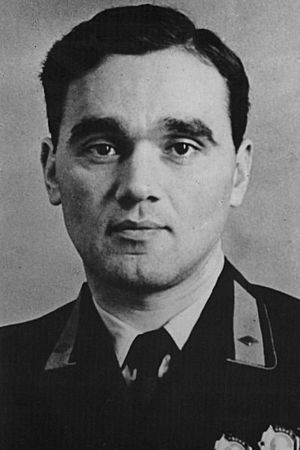Alexander Sergeyevich Yakovlev facts for kids
Quick facts for kids
Alexander Sergeyevich Yakovlev
|
|
|---|---|
| Александр Сергеевич Яковлев | |
 |
|
| Born | 1 April [O.S. 19 March] 1906 |
| Died | 22 August 1989 (aged 83) |
| Nationality | Soviet Union, Russia |
| Occupation | Engineer |
| Parent(s) | Nina Vladimirovna |
| Engineering career | |
| Discipline | Aeronautical Engineering |
| Employer(s) | Yakovlev design bureau |
| Signature | |
 |
|
Alexander Sergeyevich Yakovlev (Russian: Алекса́ндр Серге́евич Я́ковлев; 1 April 1906 – 22 August 1989) was a famous Soviet aircraft engineer. He is well known for designing many military airplanes. He also started the Yakovlev Design Bureau, a special team that creates aircraft. Yakovlev joined the Communist Party of the Soviet Union in 1938.
Contents
Early Life and Education
Alexander Yakovlev was born in Moscow. His father worked for an oil company. From 1919 to 1921, Alexander worked as a courier while still in school. In 1922, he built his very first model airplane for a school project.
Two years later, in 1924, he built a glider called the AVF-10. This glider flew for the first time on September 24, 1924. His design won an award! This award helped him get a job at the Zhukovsky Air Force Military Engineering Academy.
Even though he worked there, it was hard for him to get into the Academy as a student. This was because his family was not from a "working-class" background. Finally, in 1927, Yakovlev was accepted into the Academy. He graduated in 1931.
Designing Airplanes
While trying to get into the Academy, Yakovlev kept designing planes. In 1927, he created the AIR-1 ultralight aircraft. This was the first of ten planes he designed between 1927 and 1933.
After graduating, he started working at Moscow Aviation Plant No. 39. Here, in 1932, he set up his first design team for light aircraft. He became the main designer in 1935. Later, from 1956 to 1984, he was the chief designer for the Yakovlev Design Bureau.
World War II Aircraft
The Yakovlev Design Bureau created many fighter planes for the Soviet Air Force during World War II. Some of the most famous ones were the Yak-1, Yak-3, Yak-7, and Yak-9. They also designed the Yak-6 transport plane.
Post-War Innovations
After the war, Yakovlev continued to innovate. In 1945, he designed one of the first Soviet airplanes with a jet engine, called the Yak-15. He also created the first Soviet all-weather interceptor, the Yak-25P. This plane could fly in any weather to stop enemy aircraft.
He also designed the first Soviet supersonic bomber, the Yak-28. A supersonic plane flies faster than the speed of sound! In later years, Yakovlev was known for the Yak-42, a civilian airliner. This was a three-engine plane used for medium-range flights. He also designed many planes for aerobatics, which are amazing flying stunts.
Later Career and Retirement
From 1940 to 1946, Yakovlev served as a Vice-Minister of Aviation Industry under Joseph Stalin. Before World War II, he traveled to countries like Italy, England, and Germany. He wanted to learn about how other countries were developing their aircraft.
When the war started, he helped move aircraft factories to safer places in the east. He also made sure that plane production continued smoothly. All this time, he remained the head designer of his Bureau. In 1943, he became a member of the USSR Academy of Science. In 1946, he was given the important title of "General-Colonel of Aviation."
In 1976, Yakovlev became a full academician of the USSR Academy of Science. He also served as a representative in the Supreme Soviet of the USSR from 1946 to 1989. Alexander Yakovlev retired on August 21, 1984. He was buried in the Novodevichy Cemetery in Moscow.
Awards and Honors
Alexander Yakovlev received many awards for his work, including:
- Hero of Socialist Labour (twice)
- Lenin Prize
- Stalin Prize (six times)
- USSR State Prize
- Order of Lenin (10 times)
- Order of the October Revolution
- Order of the Red Banner (twice)
- Order of Suvorov, 1st and 2nd class
- Order of the Patriotic War of the 1st class (twice)
- Order of the Red Banner of Labour
- Order of the Red Star
- Legion of Honor, Officer (from France)
- Gold medal of the Fédération Aéronautique Internationale
See also
 In Spanish: Aleksandr Serguéyevich Yákovlev para niños
In Spanish: Aleksandr Serguéyevich Yákovlev para niños
- List of Russian aerospace engineers
- Sergey Ilyushin
- Andrey Tupolev
- Oleg Antonov

